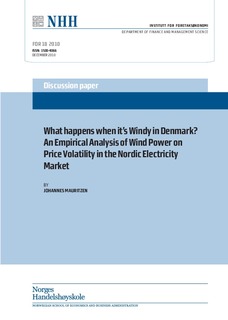| dc.contributor.author | Mauritzen, Johannes | |
| dc.date.accessioned | 2011-03-14T09:36:08Z | |
| dc.date.available | 2011-03-14T09:36:08Z | |
| dc.date.issued | 2010-12 | |
| dc.identifier.issn | 1500-4066 | |
| dc.identifier.uri | http://hdl.handle.net/11250/164007 | |
| dc.description.abstract | This paper attempts to empirically test the effect that
wind power production in Denmark has on volatility of the nord-pool wholesale electricity prices. The main result is that wind
power tends to significantly reduce intraday volatility but increases
volatility over larger time windows. The negative elasticity for intraday volatility is likely due to a larger-in-magnitude price effect
of wind power on peak hours then off-peak hours. I suggest that this in turn is due to a steeper supply schedule at peak-loads. The
positive elasticities in the wider time windows can be intuitively explained by the greater variability of the supply when large amounts
of wind power are present. These finding have ramifications for investment in power generation, balancing as well as transmission
capacity. | en |
| dc.language.iso | eng | en |
| dc.publisher | Norwegian School of Economics and Business Administration. Department of Finance and Management Science | en |
| dc.relation.ispartofseries | Discussion paper | en |
| dc.relation.ispartofseries | 2010:18 | en |
| dc.title | What happens when it's windy in Denmark?: an empirical analysis of wind power on price volatility in the Nordic electricity market | en |
| dc.type | Working paper | en |
| dc.subject.nsi | VDP::Samfunnsvitenskap: 200::Økonomi: 210::Samfunnsøkonomi: 212 | en |
| dc.subject.nsi | VDP::Teknologi: 500::Elektrotekniske fag: 540::Elkraft: 542 | en |
